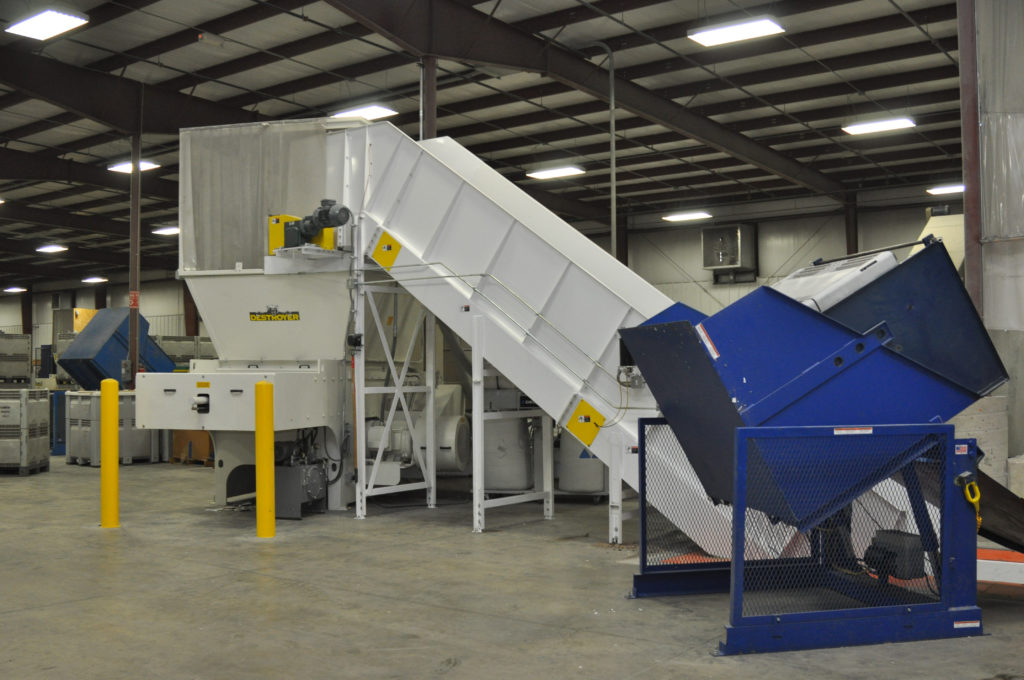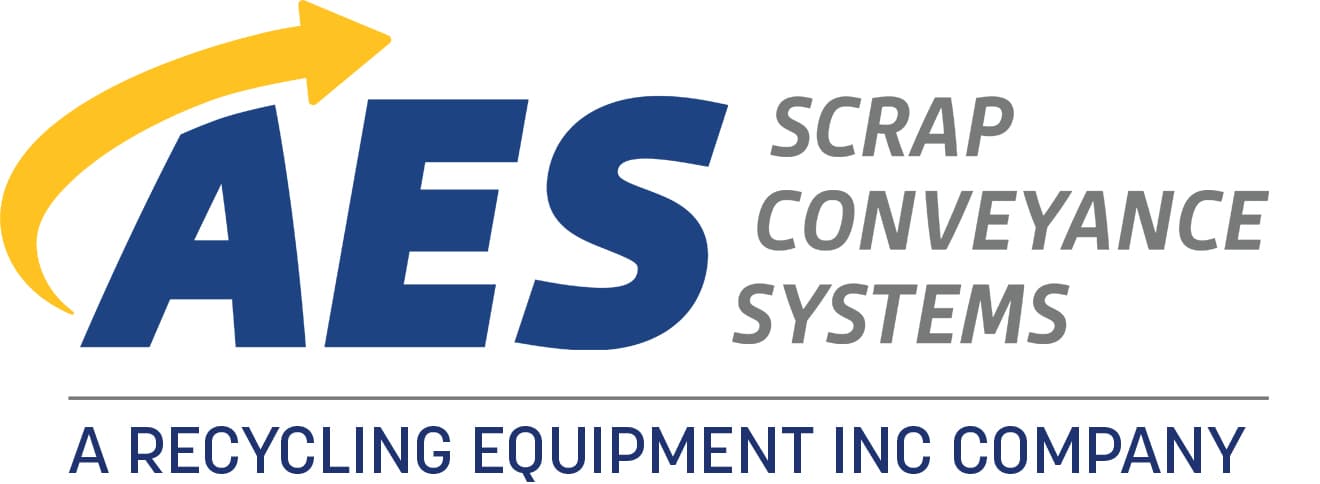
By Jeff Dietterich
President of Advanced Equipment Sales
aesjeff@aesales.net
As published in the Summer edition of SDB Magazine, August, 2015
Consolidation in the secure shredding industry has put a number of surplus shredders and complete shredding systems on the secondary equipment market. The availability of used equipment provides an attractive alternative to new equipment for those looking to enter the secure shredding industry or upgrade existing equipment or systems. But all used equipment is not created equal: There are a number of factors to ensure what you buy is suitable for your intended purpose.
The Basics. For a stand-alone shredder, one should carefully assess the equipment’s capability in terms of throughput capacity, the security level that can be achieved, the electrical requirements, and its overall condition. If these specifications match your requirements, it’s probably a good fit. On the other hand, shredding systems, whether new or used, are a sum of their individual parts. The big questions to as is, “Do the discreet components work well as an integrated system or are they mismatched?” Even if the equipment is in top condition, it’s a bad fit if the components don’t work well as a team. For instance, I recently received a solicitation for a used shredding and baling system which consisted of a large 100 horsepower strip shredder with a throughput of up to eight tons an hour. Unfortunately, the baler was a manual-tie unit with a maximum throughput of two tons per hour. Additionally, the only way to feed the shredder was via a 95 gallon container tipper. Needless to say, one could never feed eight tons of material per hour into the shredder with this container dumper, nor could the baler handle that volume of shredded paper. In this case, the only real value of this system was in the shredder itself and not the other system components.
Here are some additional things to consider when shopping for used secure destruction equipment, system, or other components:
Understand your needs and objectives, and be realistic. The security level of the shredder should be one of your first considerations. Make sure you understand the difference between strip shredders, pierce and tear shredders and single-shaft shredders, and how these different types can be arranged within a system for maximum performance. Carefully consider your throughput requirements in terms of the pounds per hour needed to address incoming material stream, and add in a factor for inefficiency in system throughput (nothing is 100% efficient). Understand the labor required to operate the system in a manner that will deliver your desired throughput, which will determine your true operating costs. As a stand-alone component, shredders can be rated by the manufacturer to handle up to ten tons or more per hour. Think carefully about the labor resources required to effectively prepare, deliver and feed a given volume into a particular type of shredder. Remember that each time the material is physically touched by an employee, there is an associated handling cost. If everything coming into your plant is already packaged in dump-ready containers your choice of equipment could be considerable different than if most of your material is coming in the door boxed on pallets.
Be realistic with your budget. The budgeting process can be challenging, as pricing for used equipment can vary greatly. Knowing the cost of equivalent new equipment can be a starting point to formulating a realistic equipment budget. Fully reconditioned equipment, ten years old or less with some form of warranty will generally command 50%-80% of the cost of new equipment, depending on age and operating hours. From this point, however, many factors coincide to determine the actual market value. Do some web research to determine market values of comparable types of equipment. Sometimes, it’s all about timing. Seller duress can certainly be an advantage to a buyer if there is a timeline in play to liquidate the equipment.
Know the condition of the equipment. Determine the equipment operating hours and look into the service history. Most shredders are equipped with non-resettable running hour meters that will show you just how long the equipment has been in operation since it left the factory. Get the equipment serial numbers and consult with the parts and service department of the manufacturer. Most manufacturers have historical records of parts sold and factory service provided for that particular machine and will be happy to share this information so they can sell you replacement parts. Look for red flags such as missing or obliterated serial numbers, missing safety guards or covers, or the lack of repair parts and service history, either from the seller or original equipment manufacturer (OEM). For instance, if you find a ten-year old shredder with 8,000 operating hours and no history of replacement cutters having been purchased, expect to be buying and installing a new set of cutters in the near future. If possible, physically inspect the equipment and observe it in operation processing material that is similar to what you will process. Check the quality of the shredded product, test for material throughput rates, take photos, and listen to the equipment operate both with and without material. If you don’t feel comfortable making these assessments yourself, engage the service of a recycling equipment sales and service professional to test, inspect and evaluate the equipment on your behalf. Be as specific as you can regarding the things that are most important to you as a prospective buyer.
Know the seller. Is the seller the actual equipment user, or are they a reseller? If dealing directly with the user you may be able to negotiate the lowest price but will likely be buying the equipment “as is, where is” with no warranty and little to no logistical or technical support. If you are dealing with an equipment broker, recycling equipment dealer, or in the case of remanufactured equipment, the factory, you can expect to pay more upfront but should also receive a higher level of logistical support for equipment removal, transportation, and installation into your facility. In some cases, the OEM can offer the equipment as factory rebuilt with a warranty. While it carries a higher price tag, you’ll gain the peace of mind knowing your equipment will be reliable and productive right out of the box. In addition to OEM’s, some equipment distributor have the capability to rebuild shredders, balers, conveyors and other system components, and can handle removal, transportation and installation.
Safety first. I cannot overstress the importance of checking all safety components of the equipment and making sure it is structurally sound and mechanically safe to operate. Make sure it is equipped with all the factory installed safety covers and guards, clearly marked emergency stop buttons and electrical service disconnects, and confirm they are all in working order. This can be tricky if you don’t know what to look for. Does the equipment come with a manual? If not, can you get a replacement from the manufacturer? You need to know how to safely operate and maintain the equipment. Remember, too, that safety standards have changed greatly over the years. As a general rule, the older the equipment, the less likely it meets with current safety standards. This is not to say that it can’t be brought up to spec by a qualified equipment dealer or the OEM, but it is something to consider in the big picture. Again, engaging an expert here can pay big dividends in peace of mind and protection for you and your employees.
Electrical Power. A common pitfall when buying both new and used equipment is not matching up its electrical requirements with the available power supply at your facility. Incompatible voltages and lack of sufficient electrical supply and infrastructure are the most common problems. This is particularly true if purchasing used equipment manufactured for use in the US and intending to use it in Canada, or vice versa. Once again, it is important to seek the help of an outside resource such as an electrical engineer or a qualified industrial electrical contractor. Upgrades to your power or changes to your electric system can be expensive, so you’ll want to be prepared with estimates for this work before you buy the equipment.
Other “hidden” costs. Nobody likes to be surprised by unexpected costs. I asked our resident service and installation expert for his take on the most common expense items that buyers often overlook. “Freight is one of the biggest variables of any job,” according to Steven Vaccaro, Service Manager at AES. “While some smaller equipment can be strapped to a pallet and placed in a van, larger equipment requires a flatbed trailer, which is a huge difference in cost. Also, don’t forget that heavy equipment will require a forklift or even a crane to both load and unload, plus riggers to perform the work”, Vaccaro says. Then there’s the actual shipment details: “I always suggest using a dedicated carrier with adequate insurance to cover the full value of your investment. Make sure any flatbed loads are tarped, too, to protect the equipment from the weather. Going across the border? Expect freight forwarding costs and possible import duties, which can be complicated and costly. These are the kinds of things that you just don’t think about until you have to”, Vaccaro says. “And don’t forget about spare parts and repairs. Unless you are buying fully reconditioned equipment, you can expect to invest at least another 25% to 50% above the purchase price on parts and service, depending on age. The cost benefits from purchasing used equipment goes away immediately if there is a major malfunction or injury as a result of operating equipment that is in disrepair.”
If your head is spinning after considering all these variables, don’t despair: Despite the potential pitfalls, good used equipment can deliver real value at significant savings over new and help you take your secure destruction business to a new level. It all comes down to knowing your needs, doing the research and buying the equipment or system best suited to your business objectives.
For more information, view our inventory of used secure destruction equipment.
